For the first time I and a Dutch relative had the opportunity to attend the 17th International Special Bikes Show – Die Spezialradmesse or SPEZI for short. We left Holland early Saturday morning, traveling through lower Germany in pouring rain until we crossed the river Ahr near Bad Neuenahr-Ahrweiler. At this point we were climbing through rolling hills on the West side of the Rhine. As we climbed the weather became drier. Then we encountered the Moselle. Here it passes through a spectacular gorge near Koblenz the main road passing over it on a high bridge with a spectacular view. By this point the road had climbed quite high and we began to travel over a rolling plateau in glorious sunshine, typical of many SPEZI photos from previous occasions.

Entrance to SPEZI Halle 1
We arrived in Germersheimshortly after 10:00 and already the area around and inside the venues was busy with attendees. We registered and received our armbands and a glossy show magazine together with a map and exhibitor list. Although this was the first time at SPEZI, and therefore there was no past to compare to, the event appeared to be very well attended, with a large number of exhibitors.

Mango Velomobile Outside Hall 1
Exhibition space comprised: three indoor halls; a large outdoor enclosure; two test tracks; plus numerous corners where a mixture of official and unofficial exhibitors, owners and homebuilders had items on display. The town of Germersheim also takes SPEZI quite seriously with several streets between the various venues closed to traffic and the town bus station given over for use as one of the test tracks.
As one would expect from reports of previous occasions, there was a large selection of interesting specialist cycling products on display. However our purpose in attending was to get to know some of the velomobile manufacturers and to see and get some hands-on experience with at least some of the velomobiles on show. No matter how much study one might make of written, pictorial or video reports, there is nothing quite like being able to touch, walk round and get inside these vehicles.
While exhibitors had come from many parts including the UK, the show, being in Germany, is German dominated. This was apparent in the selection of products as these were mainly German and Dutch made models or were being presented by German speaking resellers. Most of the Velomobile Exhibitors had an outside presence; where there was a greater opportunity to sit inside various models and, in some cases, take a test ride.
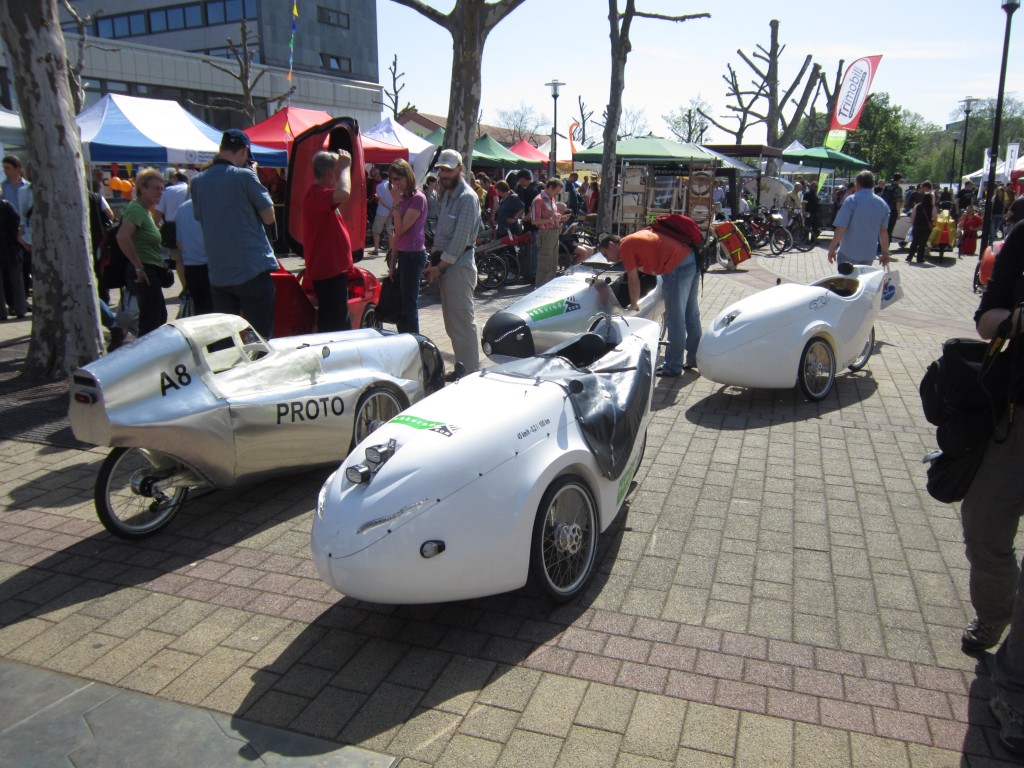
Collection of Alligt and Akkurad Alleweders
Our first encounter in the outdoor enclosure was with Carbon Recumbentsfrom Hungary. As their name suggests they manufacture recumbents from Carbon Fibre and were exhibiting a nice collection of these together with a

Carbon Recumbents’ HPV
large velomobile that they referred to simply as a HPV. They were evidently very keen to spread the word about their products and are actively looking for distributers in several countries. This velomobile was new to us and while it was only available as a static exhibit, sitting inside gave one a good sense of its potential. It is large giving it quite some road presence and has some ingenious rotating doors allowing access from either side. The front canopy was very open giving the rider good visibility.
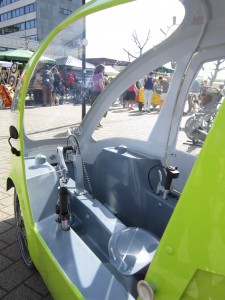
Carbon Recumbents HPV Cockpit
At the time of writing there was very little detail about their velomobile on their website but it is available with an optional electric assist.
A few stands over we found Alligt, the Dutch manufacture of the Alleweder family of velomobiles, where they were exhibiting a comprehensive range of their products. Alleweder Models A4, A6, and A7 were available and kept busy with test rides. Of particular interest were a couple of examples of the new prototype A8 reported on by Bent Blogearlier this year.
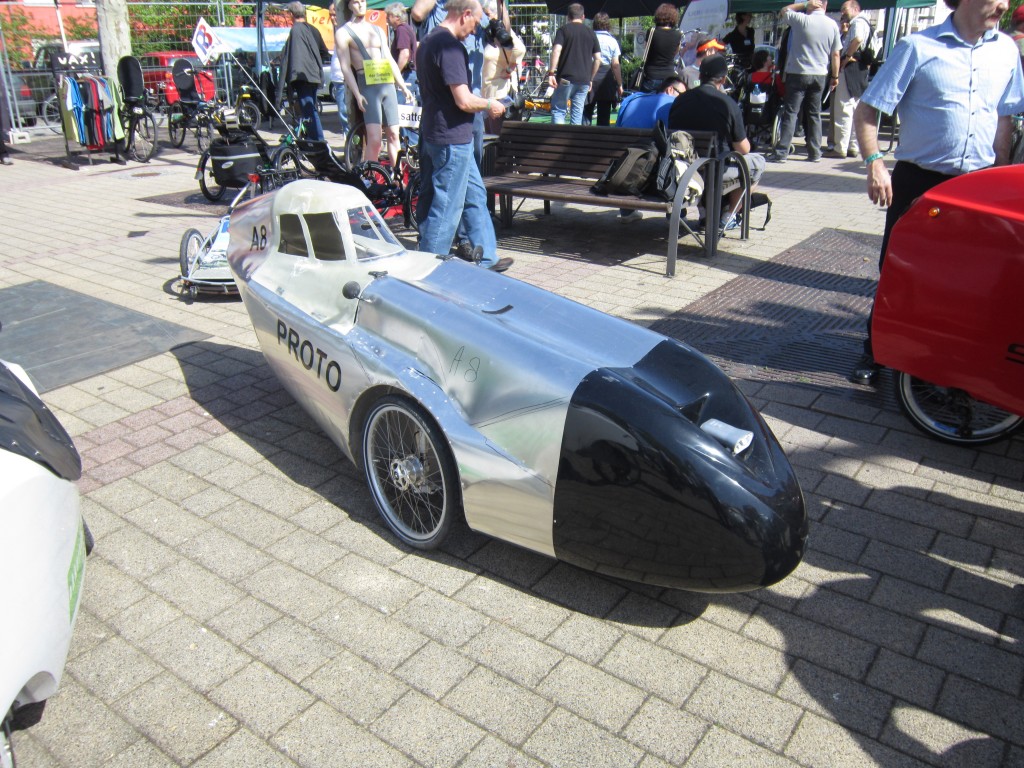
Alleweder A8 Prototype

Part built Alleweder A8 Prototype

Alligt Sunrider insides
Also on display was the Sunrider velomobile, which has undergone a redesign incorporating many parts from the Alleweder and a simpler build method, and is now being built by Alligt.
Alligt’s partner, and the German builder of the Alleweder along with an electric cycle assist system, Akkurad (Lohmeyer Leichtfahrzeuge) had a stand indoors but several of their products were being demonstrated by Alligt outside.
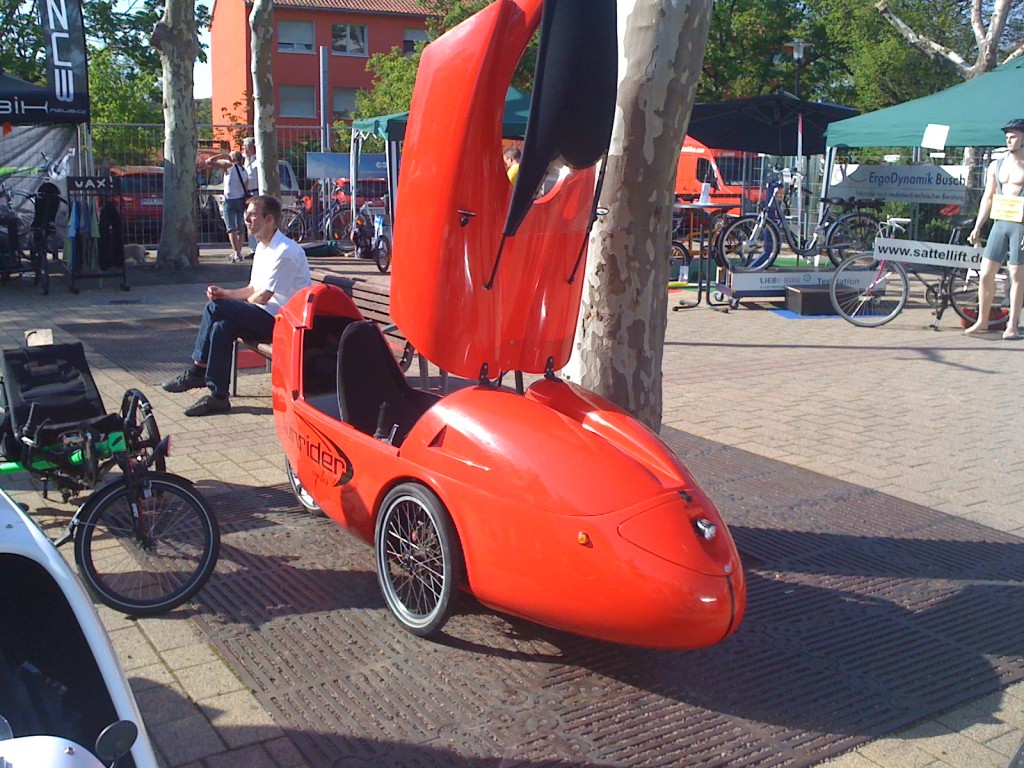
Alligt Sunrider
I had a brief opportunity to talk with Leo Visscher, who spoke about his thoughts toward producing a four-wheel velomobile. His particular interest seemed to be in the stability of a four wheeled vehicle as shown in the Moose or Elk Test and having a practical confirmation in Miles Kingsbury’s observations of the performance of his four wheeled Quatro velomobile during the ROAM last year.

Flevobike Orca
Further round the enclosure Flevobike had a large stand and were exhibiting both their Green Machine recumbent and their Orca velomobile. They had three of these, two on static display and one available for test rides. There was a lot of interest from attendees and it was frustrating that the high demand meant I was only able to experience the inside of one of the static Orcas. This was compounded by what appeared to be a disappointingly poor forward and side visibility, which I found quite restricted when compared to other designs I sampled. That being said the styling is striking and at least for myself very aesthetically pleasing and in terms of product quality the finish both inside and out has to be among the best. The standard is approaching that you would expect to find in a mass produced vehicle such as a car. My negative impression may well have been influenced by the particular Orca not being adjusted for my size and it would have been helpful to experience just how limiting the visibility was, if at all, when riding.
The final manufacturer we were able to engage outdoors was Gessthe German producer of the Leiba family of velomobiles. Gess, like many producers, is a small family firm and despite limited English, and my even more limited German, the owner and his family did their best to be helpful.

Leiba X-Stream with mounted head fairing
I was able to sample both an X-Stream and test ride a Classic. Here the experience was very positive. The X-Stream both with and without the faired head cover gave excellent visibility and the controls and seating felt very natural. I was not able to test ride the Classic till later in the day as the Leiba supplied model was taking part in a practical transport competition along side a number of other velomobiles and contraptions including a modified “stretched” Leiba Classic produced by Elmar Maierwith a child seat behind the rider. I would like to see Leiba take the hint and offer a similar design as part of their regular offerings.

Original and modified Leiba Classics
Elmar was also displaying an original design, el Loco, with a high degree of styling and a built in sound system!
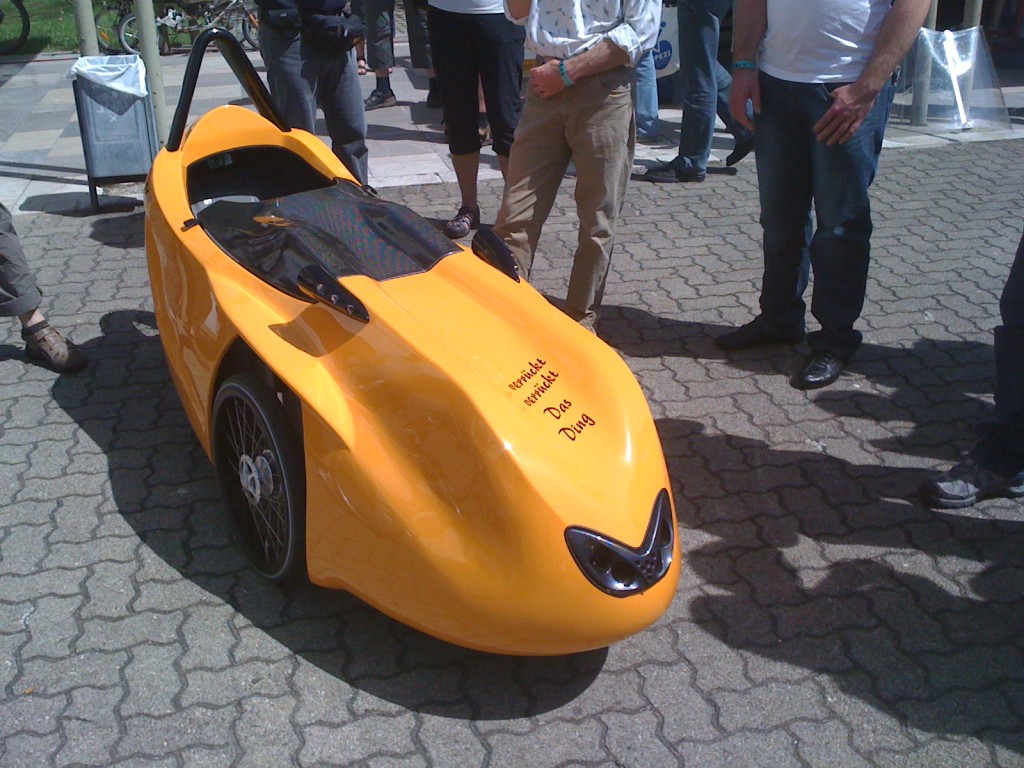
el Loco – Das Ding
The first impression after sitting down inside the Classic and latching the canopy closed and riding out toward the street was, “Wow! I feel fat!” In the few minutes that I was able to spend riding around the streets the Classic grew on me. I got used to the spacious interior and despite being enclosed on a very hot day (in UK terms) I found the inside to be well ventilated and cool. Rider Access also was excellent due to the forward opening fairing. The visibility is not as good as the X-Stream, which should be expected, but for my ride I found it quite adequate. My eye-level was on par with that of a typical sports car driver and, though there was next to no motorized traffic on the streets I used, I would feel quite comfortable at the prospect of using one in urban traffic. The only reservations would be a desire to test each velomobile more extensively in real world conditions, particularly the cold and the wet.
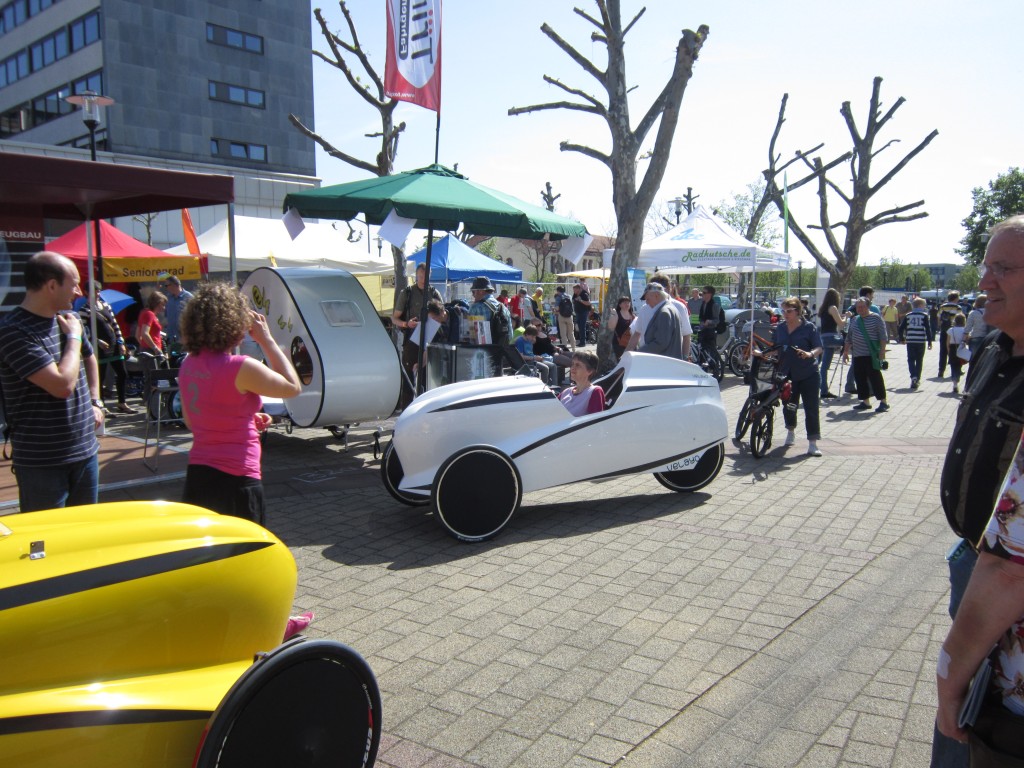
Velayos coming and going
The final exhibitor we saw in the outdoor enclosure was Fortschritt Fahrzeugbaumakers of the front wheel drive rear wheel steering Velayo velomobile. They had a couple of Velayos and again they were kept busy giving test rides to others which prevented us from getting any hands on experience for ourselves. None-the-less I saw and heard them pass on the streets several times and had on opportunity toward the end of the day to make an external inspection. One was impressed by the bulk and low rumble as they passed and despite the unconventional configuration, even as velomobiles go, there was evidently a lot of interest.
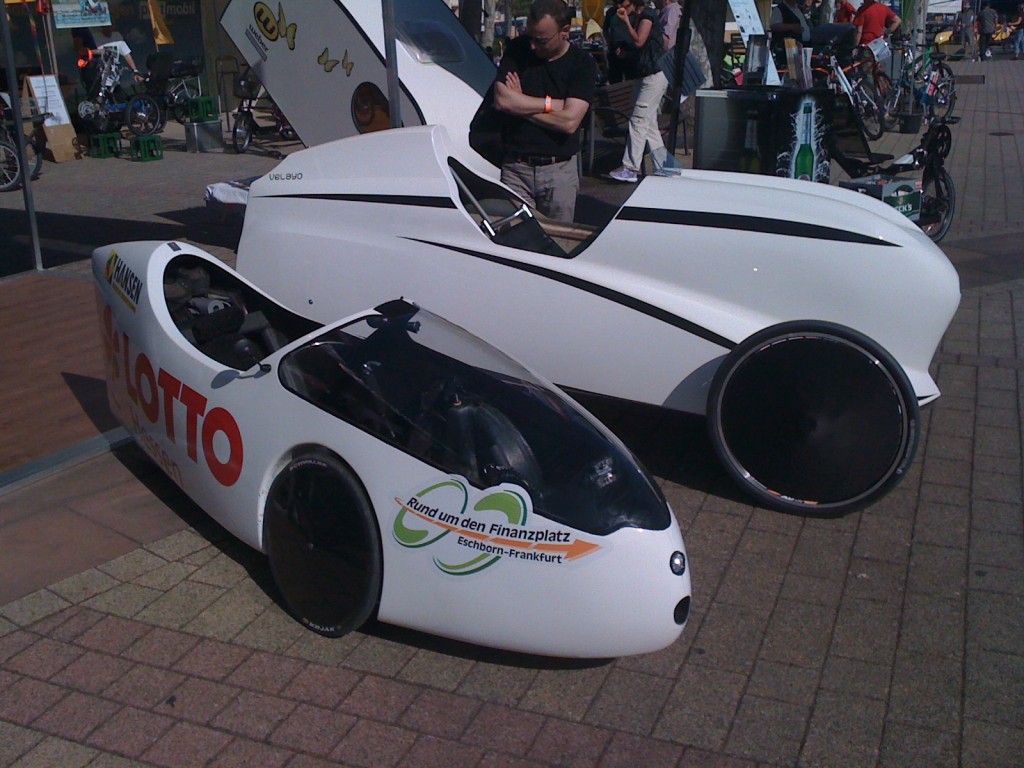
Velayo and Go-One Evolution
When I photographed the Velayo I inspected, I also included a Go-One Evolution that was parked up alongside. It was unclear whether this was just a private owner’s vehicle or whether Fortschritt Fahrzeugbau were exhibiting the Go-One on behalf of the manufacturer Beyss Leichtfahrzeuge.

Veltop mounted on a recumbent
For those looking for elements of the velomobile experience while still using a regular bike or recumbent, there were also several vendors offering fairing solutions and french manufacturer Veltop had installed examples of their weather protection system.
Of the remaining velomobile exhibitors only Sinner and Raederwerkwere limited to indoor exhibition space but examples of their Mango and Milan velomobiles were parked up in various places outside giving ample opportunity for inspection.
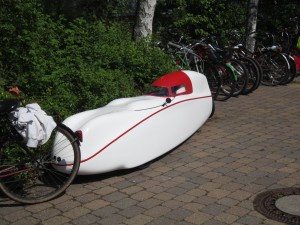
Milan Velomobile
Hase Bikesalso had an indoor stand where they were exhibiting their Klimax all weather delta trike. It was a disappointment that the indoor space was so limited and busy with other interested potential velomobilists that we did not get the opportunity we would have liked to talk with the exhibitors.

Hase Klimax
One significant omission on our part was Bike-Revolution, who had both an indoor and out door stand. Regrettably we were not aware they were representing Leitra, along with their own related offerings, the Interceptor , Thunderstorm, Leitra Avancee, till after the event. This is an omission we will try to avoid, if at all possible, next year.
Present in an unofficial capacity were Jouta, the Dutch manufacturer of an interesting: rear wheel steering, front wheel drive, leaning, recumbent trike for which they make a striking fairing. They had an example on display with rear-mounted panniers for luggage in a similar style to the original Go-One velomobile.

Jouta Velomobile
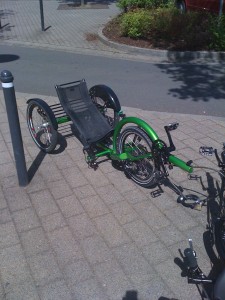
Jouta Front Wheel Drive Trike
Their website, only available in Dutch and currently undergoing a rebuild, claims that the fairing is also suitable for mounting to other trikes. While I was not able to test the trike with the fairing I was able to test ride a bare trike and despite the negative reputation of rear wheel steering I found the ride quite stable over the speeds I achieved and under the pedal loads I applied. I found the ride unusual but satisfactory and very enjoyable.
After the exhibition spaces there were the two test tracks. We did not have time to sample the electric test track; instead I went along to the bus station where the merely human powered vehicles were available.
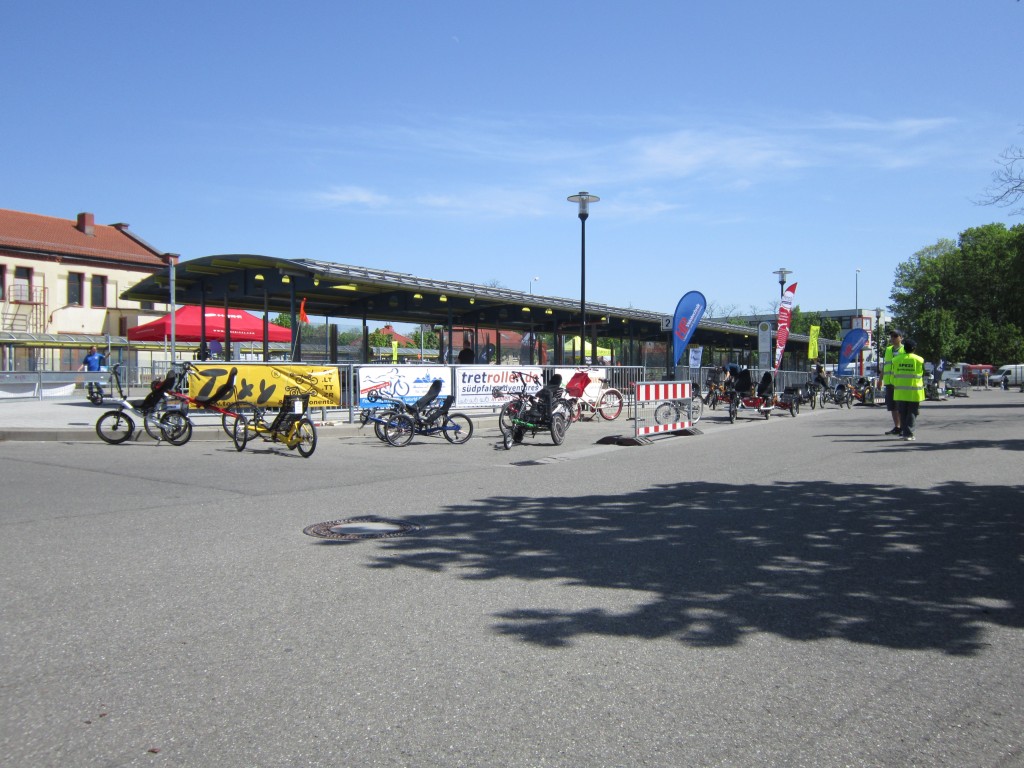
SPEZI test track before the le Mans start
The tracks are sponsored by several of the biggest exhibitors as an opportunity to try before making a buying decision. As such there were machines provided by the likes of HP Velotechnik, Hase, AZUB, Toxy, Anthrotech, among others, but no velomobiles. Each tryout session was limited to 25 minutes and to gain entry you had to register and leave some photo ID in return for a coloured badge. At the end of the previous session the testers left the enclosure and were replaced by those who had the current badge. I took the opportunity to try out several of the offerings. While there were no actual velomobiles the time was not wasted as there are options to add fairings to existing trike and bike models and the Hase Klimax is based on the Kettwiesel delta trike.
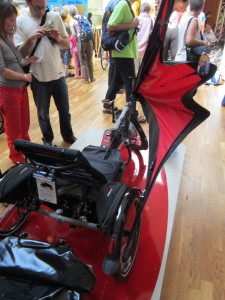
Hase Klimax
I have ridden both recumbent bikes and tadpole trikes before but this was my first time on a delta. It was a good experience and I was able to appreciate the potential of this configuration. Given the limited speed allowed and surface available the Kettwiesel handled very well and was a pleasure to ride. Based on that assessment I would say, that for those looking for the cabriolet velomobile experience, the Hase Klimax is certainly worth a closer look.
Looking back at the day one might contrast the value of the visit to velomobil.nl in Dronten with our trip to SPEZI the following day. The test experience, attention and interaction with the builder was far more in depth with the manufacturer visit whereas at SPEZI one was competing with numerous other attendees and one could sense the strain some of the exhibitors were under as they struggled to cope with the multi-lingual requests for information. That being said, while you don’t get as much time, you cannot beat SPEZI for the opportunity to sample so many different models within walking distance of each other. If nothing else: the mental stimulation of seeing so many innovative products; the memories of the smiling faces on the test track; and the experience of something different, make the euro 9.50 entrance fee excellent value for a day out.
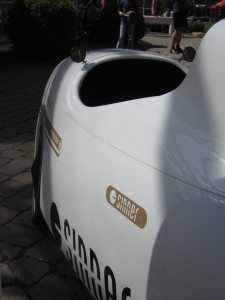 In conclusion, like all engineering, each velomobile is a set of tradeoffs to obtain a particular solution. There is not necessarily one right answer or perfect velomobile and all the different designs are not necessarily in direct competition with one-another. What works well for one rider in one place may be quite unsuitable for another, who is say, a different size, or in a different environment. The importance must be stressed of gaining experience for one’s self with several designs and correctly identifying your own needs and priorities.
In conclusion, like all engineering, each velomobile is a set of tradeoffs to obtain a particular solution. There is not necessarily one right answer or perfect velomobile and all the different designs are not necessarily in direct competition with one-another. What works well for one rider in one place may be quite unsuitable for another, who is say, a different size, or in a different environment. The importance must be stressed of gaining experience for one’s self with several designs and correctly identifying your own needs and priorities.
Finally I would like to express my own thanks not only in general to those who run SPEZI but also personally to all my family and friends who helped to make this trip possible.

A Question
 Jouta, whose own velomobile was covered in this year’s SPEZI report, now have their new website online. In addition to their original front wheel drive delta trike and fairing they also report that they are very busy building sunrider velomobiles. They say they are working hard developing a new type of sunrider. It is unclear whether this is an independent effort or if it is being done in collaboration with Alligt.
Jouta, whose own velomobile was covered in this year’s SPEZI report, now have their new website online. In addition to their original front wheel drive delta trike and fairing they also report that they are very busy building sunrider velomobiles. They say they are working hard developing a new type of sunrider. It is unclear whether this is an independent effort or if it is being done in collaboration with Alligt.
























